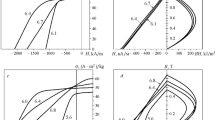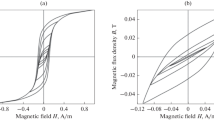Abstract
The increasingly stringent requirements on modern equipment lead to the creation of special alloys that possess a specific set of physical, mechanical, and other properties for the most efficient operation of machine parts and equipment. This group includes magnetically hard alloys for electronics and electrical engineering that should possess variable magnetic properties in combination with high mechanical and other characteristics. In each case attainment of the requisite set of properties is a complicated problem that takes much resources and time. In this connection the development of methods for manufacturing these alloys by means of predicting and computing at least some of their properties is of great practical interest and will make it possible to replace a major portion of lengthy and expensive experiments by computer methods.
Similar content being viewed by others
References
B. E. Vintaikin and R. N. Kuz'min,Metallofizika,9(3), 16–21 (1987).
B. E. Vintaikin, R. N. Kuz'min, and E. A. Sukhareva,Kristallografiya,35(2), 414–417 (1990).
H. Kaneko, M. Homma, and Y. Nakamura,J. Magn. Magn. Mater., No. 5, 1088–1192 (1972).
E. E. Yurchikov, V. V. Serikov, G. V. Ivanova, et al.,Fiz. Met. Metalloved.,44(1), 65–71 (1977).
T. Minowa, M. Okada, and M. Homma,IEEE Trans. Magn.,16(3), 529–533 (1980).
B. E. Vintaikin, V. A. Golikov, V. V. Dudarev, and I. G. Sapkova,Fiz. Met. Metalloved., No. 4, 73–78 (1991).
T. Nishizawa, M. Hasebe, and M. Ko,Acta Met.,27(3), 817–828 (1979).
B. E. Vintaikin and R. N. Kuz'min,Fiz. Met. Metalloved.,64(1), 101–106 (1987).
V. B. Nikanorov, A. P. Seleznev, and B. A. Yakovlev,Izv. Vuzov. Ser. Élektromekhanika, No. 3, 49–54 (1987).
B. E. Vintaikin, M. A. Libman, and N. N. Potapov,Fiz. Met. Metalloved., No. 6, 104–108 (1991).
Author information
Authors and Affiliations
Additional information
Translated from Metallovedenie i Termicheskaya Obrabotka Metallov, No. 12, pp. 12–14, December, 1997.
Rights and permissions
About this article
Cite this article
Vintaikin, B.E. Laws of structure formation and magnetic properties of magnetically hard alloys based on the Fe−Cr−Co system. Met Sci Heat Treat 39, 512–515 (1997). https://doi.org/10.1007/BF02471369
Issue Date:
DOI: https://doi.org/10.1007/BF02471369




